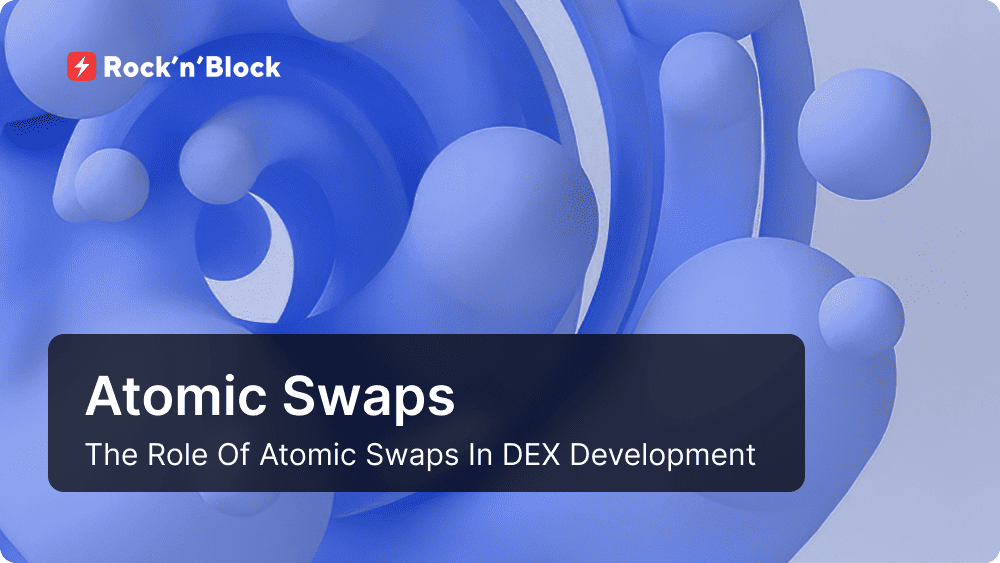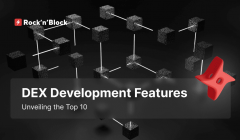The Role of Atomic Swaps in DEX Development
03 May 2024Decentralized exchanges have emerged as a revolutionary force in the world of cryptocurrency, providing users with a more secure, transparent, and trustless environment for trading digital assets. Unlike traditional centralized exchanges that act as intermediaries, DEX operates on blockchain technology, allowing users to trade directly from their wallets without the need for a third party to hold their funds. In this article, we will delve into the pivotal role played by atomic swaps in DEX development.

Table of Contents
- Brief Overview of Decentralized Exchanges
- Evolution of DEX Software Development and the Need for Atomic Swaps
- Understanding Atomic Swaps
- Key Components of Atomic Swaps in DEX Development
- Use Cases of Atomic Swaps in DEX Development
- Conclusion
Brief Overview of Decentralized Exchanges
Decentralized exchange development represents a change of paradigm in the cryptocurrency landscape, and demonstrates the core principles of blockchain technology - decentralization, transparency and resistance to censorship. These platforms empower users by granting them control over their private keys and funds. This reduces the risk of hacks or security breaches associated with centralized counterparts.
DEX operates through smart contracts development. Smart contracts are self-executing contracts with the terms of the agreement directly written into code. This eliminates the need for an intermediary to facilitate trades, fostering a peer-to-peer trading experience. Some popular DEX platforms, such as Uniswap, SushiSwap, and PancakeSwap, contribute to the expanding ecosystem of DeFi development.
Learn Top 10 features of DEX development in our comprehensive article!
Evolution of DEX Software Development and the Need for Atomic Swaps
Traditional DEX platforms operate within a single blockchain, limiting trading to only assets belonging to that network. To remove this limitation, DEX developers have created a cross-chain trading capability. Despite the revolutionary possibilities of this technology, it has some associated drawbacks, articularly in terms of cross-chain interoperability and security concerns.
Here's how the need for atomics swaps came about. Atomic swaps is a groundbreaking solution to the cross-chain challenges. Atomic swaps allow users to trade different cryptocurrencies directly, across different blockchains, without the need for a trusted third party.
Imagine you have apples and your friend has oranges. You want to exchange one of your oranges for one of their apples. Atomic swaps ensure that either both the apple and the orange are swapped, or nothing happens at all. This eliminates the need for a middleman, making trades faster and more secure. Without atomic swaps, you might have to trust a third party to make sure you get your apple after giving away your orange. In DEX development, atomic swaps give you the power to trade directly with others, keeping your transactions safe and efficient.
This innovation has become increasingly crucial as the cryptocurrency space expands, with numerous blockchains and tokens coexisting.
Understanding Atomic Swaps
Atomic swaps, also known as atomic cross-chain trading, enable the trustless exchange of cryptocurrencies across different blockchain networks. The term 'atomic' refers to the undivided or complete nature of the exchange - either the entire transaction takes place or nothing happens at all. This characteristic ensures that users do not face the risk of partial fulfillment or loss during the swapping process.
Atomic swaps use smart contracts, but they are a specific type of smart contract designed for cross-chain compatibility.
How Atomic Swaps Work
Atomic swaps rely on smart contracts, particularly Hash Time Locked Contracts (HTLCs). HTLCs use cryptographic hash functions and time locks to ensure both parties meet their agreed terms within a specified period of time. The steps involved in an atomic swap typically include:
1. Initiation: The process begins with one party initiating the swap by creating an HTLC, locking the funds they wish to exchange.
2. Revelation of Hash Secret: This party (the initiator) generates a cryptographic hash and sends it to the counterparty, who then decodes the corresponding secret.
A cryptographic hash function is like a secret code or fingerprint for data. It takes input (any kind of data) and produces a fixed-size string of characters, which looks like a random sequence. Even a tiny change in the input data results in a completely different hash. This property makes cryptographic hash functions useful for verifying the integrity of information.
3. Confirmation and Execution: Upon successful verification of the hash secret, both parties confirm the details of the swap. The smart contract is executed, releasing the funds to their respective owners.
4. Completion or Refund: If one of the parties fails to complete their part of the transaction within the agreed time, the funds will be returned to their original owners.
This process ensures that the exchange occurs securely and without the need for trust between the parties involved. The transparency and immutability of blockchain technology play a pivotal role in guaranteeing the integrity of the atomic swap.
Advantages of Atomic Swaps in DEX Development
1. Trustless Trading: Atomic swaps make trading safer by removing the need for trust in others or middlemen. This decentralized approach reduces the risk of fraud, ensuring both parties stick to the agreed-upon terms.
2. Enhanced Security: Smart contracts, especially HTLCs, boost security by setting conditions for the swap. This prevents unauthorized or incomplete transactions, adding an extra layer of protection.
3. Cross-Chain Interoperability: Atomic swaps enable seamless trading across different blockchain networks, breaking down barriers and promoting interoperability. This is crucial for the DeFi projects development.
4. Privacy: Atomic swaps happen directly between users' wallets, offering more privacy compared to traditional exchanges. Users keep control over their private keys, making the trading experience more private and secure.
Key Components of Atomic Swaps in DEX Development
Smart Contracts
Smart contracts form the foundational building blocks of atomic swaps in decentralized exchange development. These self-executing contracts are coded with predefined rules and conditions that automate the execution of the swap when met. In the context of atomic swaps, smart contracts act as the medium through which users establish the terms of the exchange and ensure that the process is trustless and secure. By eliminating the need for a central authority, smart contracts contribute to the decentralized nature of atomic swaps, allowing users to transact directly with one another.
Hash Time Locked Contracts (HTLC)
Hash Time Locked Contracts (HTLC) are a type of smart contract that is essential for the functionality of atomic swaps. These contracts use cryptographic hash functions and time locks to ensure a seamless and secure exchange process. The use of hash functions enables parties involved in the swap to verify information authenticity without sharing confidential details. Time locks dictate a specific timeframe within which the swap must be completed. If the conditions are not met within the specified timeframe, the contract can be canceled. This prevents potential issues such as indefinite lockups of funds. HTLCs play a pivotal role in ensuring the atomicity and reliability of the exchange process.
Use Cases of Atomic Swaps in DEX Development
Cross-Chain Trading
One of the primary real-world applications of atomic swaps in decentralized exchange development is facilitating cross-chain trading. The advent of atomic swaps opens up new possibilities for traders and investors, allowing them to access a broader range of assets and take advantage of opportunities on various blockchain networks. Cross-chain atomic swaps help to break down barriers between different cryptocurrencies, creating a more interconnected and versatile decentralized financial ecosystem.
Decentralized Finance (DeFi) Integration
DeFi development is a fast-growing sector in the cryptocurrency space that aims to recreate traditional financial services on decentralized platforms. Atomic swaps play a significant role in integrating DeFi protocols and services within the decentralized exchange ecosystem. DeFi applications, such as decentralized lending, borrowing, and yield farming development, often require seamless and trustless trading between different assets. Atomic swaps offer a secure and direct way for users to execute trades from their wallets, without relying on centralized exchanges. As DeFi evolves, atomic swaps will play a crucial role in supporting the various financial instruments and services within this decentralized paradigm.
Conclusion
As atomic swaps continue to mature and find wider adoption, they are poised to play a central role in shaping the future of decentralized finance, driving innovation, and fostering a truly open and inclusive financial system. The path ahead holds exciting possibilities, and as the cryptocurrency landscape evolves, the synergy between DEX development and atomic swaps will remain a key force propelling the industry into new realms of possibility.
We ❤️ Development
Follow us on social media to receive the hottest blockchain development updates
Twitter ⚡️Telegram⚡️LinkedIn⚡️Facebook⚡️Linktree










